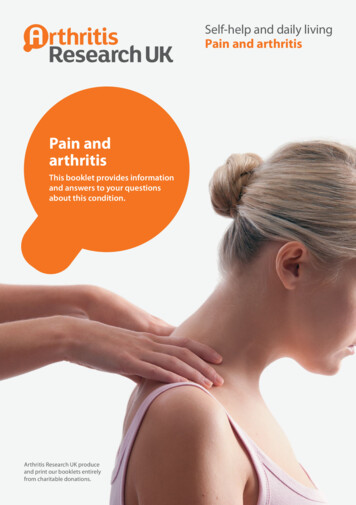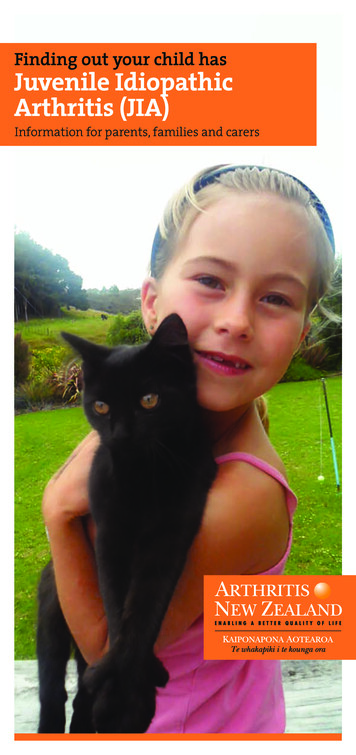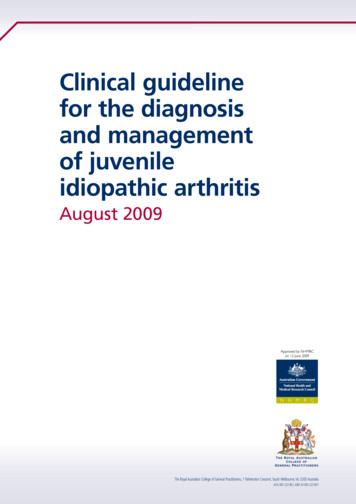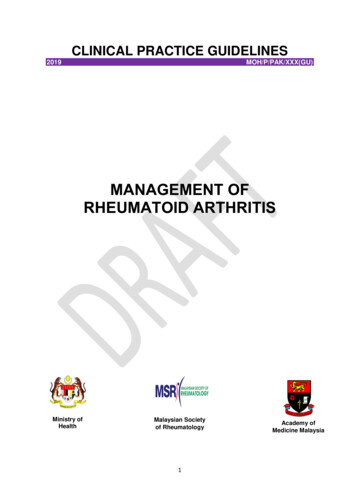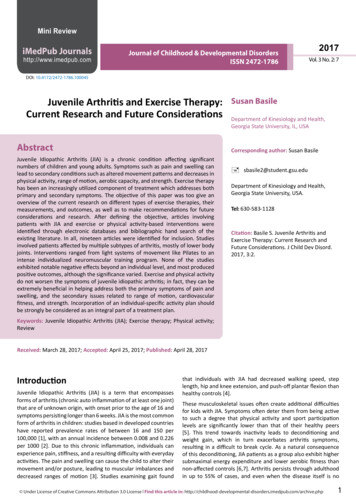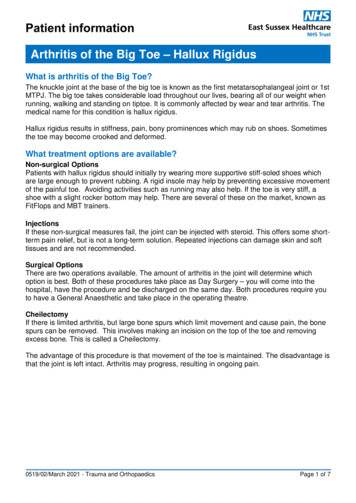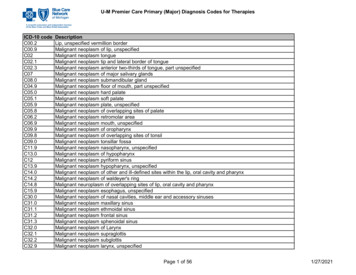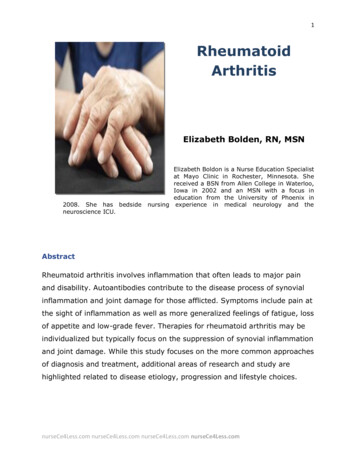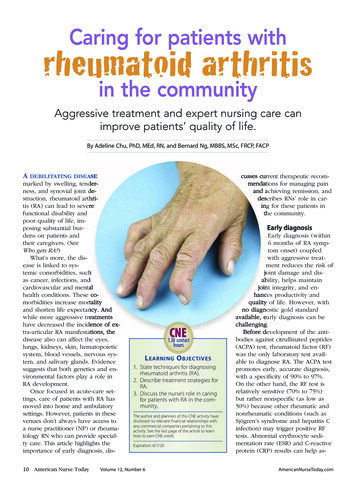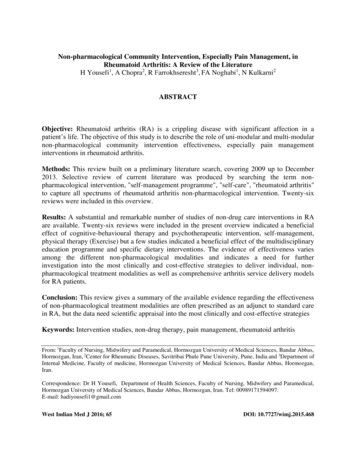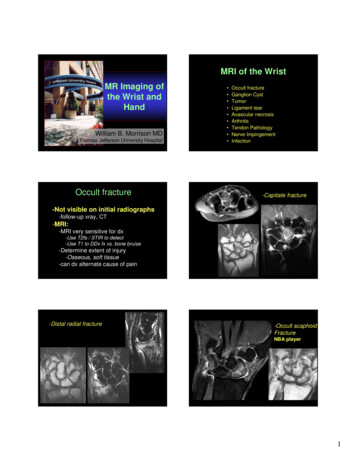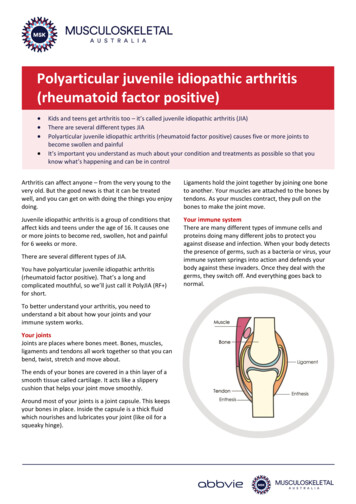
Transcription
Polyarticular juvenile idiopathic arthritis(rheumatoid factor positive) Kids and teens get arthritis too – it’s called juvenile idiopathic arthritis (JIA)There are several different types JIAPolyarticular juvenile idiopathic arthritis (rheumatoid factor positive) causes five or more joints tobecome swollen and painfulIt’s important you understand as much about your condition and treatments as possible so that youknow what’s happening and can be in controlArthritis can affect anyone – from the very young to thevery old. But the good news is that it can be treatedwell, and you can get on with doing the things you enjoydoing.Ligaments hold the joint together by joining one boneto another. Your muscles are attached to the bones bytendons. As your muscles contract, they pull on thebones to make the joint move.Juvenile idiopathic arthritis is a group of conditions thataffect kids and teens under the age of 16. It causes oneor more joints to become red, swollen, hot and painfulfor 6 weeks or more.Your immune systemThere are many different types of immune cells andproteins doing many different jobs to protect youagainst disease and infection. When your body detectsthe presence of germs, such as a bacteria or virus, yourimmune system springs into action and defends yourbody against these invaders. Once they deal with thegerms, they switch off. And everything goes back tonormal.There are several different types of JIA.You have polyarticular juvenile idiopathic arthritis(rheumatoid factor positive). That’s a long andcomplicated mouthful, so we’ll just call it PolyJIA (RF )for short.To better understand your arthritis, you need tounderstand a bit about how your joints and yourimmune system works.Your jointsJoints are places where bones meet. Bones, muscles,ligaments and tendons all work together so that you canbend, twist, stretch and move about.The ends of your bones are covered in a thin layer of asmooth tissue called cartilage. It acts like a slipperycushion that helps your joint move smoothly.Around most of your joints is a joint capsule. This keepsyour bones in place. Inside the capsule is a thick fluidwhich nourishes and lubricates your joint (like oil for asqueaky hinge).
However sometimes with conditions like PolyJIA (RF ),the immune system gets a little confused and attacksthe healthy tissues it’s supposed to protect, includingyour joints. Your immune system launches an attack anddoesn’t stop.What is PolyJIA (RF )?Let’s break the name up so we can understand moreabout your condition. Poly means many. In PolyJIA (RF ), five or more ofyour joints will become red, swollen and painfulwithin the first 6 months of your developing it.Articular refers to joints.Juvenile means that your condition affects peopleunder the age of 16 years.Idiopathic means that we don’t know what causesthe condition to occur.Arthritis means inflammation of the joint.Rheumatoid factor is a protein that the immunesystem produces that can attack healthy tissue inyour body.Positive means the blood test looking for theprotein rheumatoid factor found it present in yourbody. The absence or presence of rheumatoidfactor helps your doctor work out which type of JIAyou have and how to best treat it.So PolyJIA (RF ) is a condition that affects many joints,causing pain and inflammation, and the blood testlooking for the presence of rheumatoid factor waspositive.PolyJIA (RF ) most commonly affects teenage girls,however boys can also develop it.PolyJIA (RF ) not only affects the joints, it can also affectother parts of the body.What are the symptoms?The symptoms experienced by people with PolyJIA (RF )varies. No one experiences the exact same set ofsymptoms or to the same degree.Some people may get a lot of pain and inflammation.Others may not have as much. Some may have lots ofjoints involved, while others may only have five.It’s impossible to know how your condition will developover time.Symptoms of PolyJIA (RF ) can include: pain and swelling in your joints - especially those inyour hands and feet - though it can also affect yourbigger joints (e.g. knees, hips)joint involvement is usually symmetrical – thatmeans if one knee is affected, the other one willlikely be affected as welljoint stiffness, especially when you get up in themorningsome people develop nodules – these are small,firm lumps that form under the skin, usually overjointsother parts of the body including the liver, spleenand lymph glands may be affectedeye involvement (dry eyes or inflammation) cansometimes occur.At times you may go through a period where yourarthritis is more painful, you experience moreinflammation and fatigue (or tiredness). This is called a‘flare’. We don’t always know what causes a flare, butwe do know that stress or an illness can trigger one.Flares are temporary, and will need to be managed byyour doctor. They can be frustrating and painful whilethey last.Remember, everyone’s different, and will have differentsymptoms. You may not experience all of the symptomslisted here. It’s impossible to know. If you do notice anychanges to your symptoms, talk with your doctor.Why did I get PolyJIA (RF )?No one knows what causes some people to developPolyJIA (RF ). It’s thought that it may be the result ofgenetic factors (or things you’ve inherited) andsomething from your environment (e.g. an infectionthat hasn’t been identified).Is PolyJIA (RF ) contagious?No, your condition isn’t contagious. You didn’t catch itfrom anyone, and no one can catch it from you.What happens now?You’ll need to see your doctor regularly so that they cankeep up with how you’re doing. You’ll see your usual GPfor day-to-day stuff. However you’ll also see a specialist- a paediatric rheumatologist – who’s an expert inconditions that affect muscles, bones and joints.You won’t see your paediatric rheumatologist as oftenas your GP, but they’ll work together to make sure youget the best possible care.263–265 Kooyong Road Elsternwick 3185 PO Box 130 Caulfield South 3162Telephone: 03 8531 8000 MSK Help Line: 1800 263 265 info@msk.org.au www.msk.org.au2
Your GP and paediatric rheumatologist will ask you: how you’re feelingabout your pain levelsif you’re having any other problems (e.g. sleeping,being active, keeping up at school)if you’re having problems with your medication (e.g.they make you feel unwell, you’re forgetting to takethem).They’ll also physically check out your joints by looking atthem and feeling how they move.Occasionally you may need to have tests (e.g. bloodtests, x-rays) to see how your medications and othertreatments are working.Do I have to take medication?Most people with JIA – regardless of the type – will haveto take some form of medication at some time. Itdepends on the symptoms you’re experiencing. Thereare many different types of medications that work indifferent ways.Your doctors will always start with the simplestmedications at the smallest doses and work their wayup to more complex medications and larger dosesdepending on how your JIA responds to the treatments.Medications may include:Pain relievers (analgesics) – medications likeparacetamol can provide temporary pain relief.Non-steroidal anti-inflammatories (NSAIDs) – there areover-the-counter NSAIDs that you can buy at thepharmacy or supermarket, as well as prescriptionNSAIDs. They work to help control inflammation andprovide temporary pain relief.Corticosteroids – these medications are used to quicklycontrol or reduce inflammation. They can be injected orswallowed. Corticosteroid injections - if a joint is particularlypainful and swollen, an injection directly into thejoint can help to quickly relieve your pain andinflammation.Corticosteroids (liquid or tablets) – such asprednisolone, are used in the early days of yourcondition, or if you’re going through a flare, to getthe inflammation under control. They do have sideeffects if used for long periods, so your doctor willclosely monitor you while you’re taking them.Disease modifying anti–rheumatic drugs (DMARDs) –this group of medications work on controlling youroveractive immune system. They can help relieve painand inflammation, and can also reduce or prevent jointdamage. These medications can take months to kick in,so you may also need to take other medications to helpcontrol pain and inflammation until then. A commonlyused disease modifying drug for JIA is methotrexate.Biologics (bDMARDs) – these newer medications arealso a type of disease modifying drug, and they alsowork on controlling your immune system. Howeverunlike other disease modifying drugs, biologics targetspecific cells and proteins that are causing theinflammation and damage, rather than hitting yourentire immune system.Depending on your particular symptoms, and how muchpain and inflammation you have, you may take onemedication or a combination of different medications.All medications have side effects. Fortunately most ofthe side effects are mild. You may not even experienceside effects. However if you do feel unwell, or strangeafter taking any medications, talk with your parents,doctor or nurse immediately.What other health professionals will see?Apart from your GP and paediatric rheumatologist,you’ll work with other health professionals including:Physiotherapists, or physios, may work with you fromtime to time to make sure your joints continue to moveand work properly. They’ll develop an exercise programthat’s specific to you. This will help you maintain the fullrange of movement in your affected joints andstrengthen your muscles. Physios can also show youdifferent things you can do to help manage your pain.Occupational therapists, or OTs, help you learn betterways of doing everyday activities. Your JIA might makethings like getting dressed and managing at school moredifficult, particularly if it affects your hands. Somepeople may also need to use splints (special bracesmade of plastic or other materials) at times to relieveinflammation and help prevent future joint problems.OTs can help you deal with all of this.Ophthalmologist/optometrist, or eye specialists willmonitor your eyes and take care of them if needed.Podiatrists are experts in feet. Because PolyJIA (RF )often affects the joints in feet you may need to see apodiatrist. They can give you advice on shoes that’ll bebest for your feet, and can provide orthotics if needed.Orthotics are special inserts for your shoes that provideyour feet with proper support.263–265 Kooyong Road Elsternwick 3185 PO Box 130 Caulfield South 3162Telephone: 03 8531 8000 MSK Help Line: 1800 263 265 info@msk.org.au www.msk.org.au3
You may also occasionally see other healthprofessionals, especially if you need to talk about youremotions (psychologist or psychiatrist), get help withour diet (dietitian) or get advice on your medications(pharmacist).Keep track of how you’re going. Write down how yoursymptoms are, when you feel better or worse, how youractivity levels are, if you’re getting a good night’s sleep,how the medications you’re taking are going, and if youhave any side effects.All of these people will work together to help you livewell with PolyJIA (RF ).Having this information in one place will help when youvisit your doctor. Your doctor will be able to see howyou’re going and if your treatment is working or needsadjusting. You can write this information in a notebook,or download one of the many apps available for trackingthis information.What can I do?Follow your treatment plan. It’s extremely importantthat you follow the plan that your health professionalshave developed for you. That means taking yourmedications as they’ve been prescribed, doing theexercises your physio and OT have given you, using anygadgets you’ve been given to help protect your joints,and letting your doctor know of any changes to yoursymptoms and how you’re feeling. All of these thingsgive you a better chance of managing your PolyJIA (RF )well and reducing the risk of long-term problems.Exercise and stay active as much as possible. Exercisehas so many health benefits. It helps keep your bones,muscles and joints healthy, improves your mood, canhelp you sleep better and helps keep you at a healthyweight. It’s also fun – especially when you’re withfriends and team mates.Know what helps you manage your pain. Try differentthings so you know what works for you. For exampleyou might find heat packs or ice packs help reduce jointpains, listening to your favourite music relaxes you andhelps ease tense muscles, a warm bath or shower getsstiff joints moving and medicines can provide temporarypain relief. Don’t rely on just one thing to help you dealwith pain – have a few tricks up your sleeve to deal withdifferent situations.Eat well. While no foods can make your JIA better orworse, having a healthy, well-balanced diet with a widerange of foods is best for overall good health. Eating anutritious diet will also help you to control your weight.This is important for many health reasons, but when itcomes to your joints, being overweight puts extra strainon them (especially the joints in your hips, knees andfeet) which will add to your pain.Know what to do when you have a flare. Flares canoccur out of the blue, so talk with your doctor and workout a plan for what to do when you have a flare. Youmay need to do things like take short rest breaks duringthe day or adjust your medications. Having a plan inplace means you’ll be prepared and know what to do.Talk with your teachers. Many teachers have never metsomeone with JIA. They may not know that you can feelgreat one day, and terrible the next. You and yourparents can talk with your teachers about how yourcondition affects you and how it may affect you atschool. Your paediatric rheumatology nurse, OT andphysio will also be able to provide information to yourteachers and school.Talk with your friends. It’s up to you how much youwant to tell your friends and classmates about yourcondition. It can sometimes be helpful if your closefriends know what you’re experiencing as they can bevery supportive.Don’t be too hard on yourself and changes to yourbody. There are some things that you just can’t control.Your arthritis may affect how you look from time totime. Some of your joints may look swollen or red and abit different to how your friend’s joints look. Somemedications can make you put on a little weight andyour face may get puffy. This won’t last forever. Justkeep following your treatment plan – take yourmedications, exercise, eat well, go to school and hangout with friends. If you’re really worried about thesechanges, talk with your doctor, your parents or yournurse.It’s ok to feel sad. It’s perfectly natural that from time totime you may feel sad, frustrated, anxious or angryabout having PolyJIA (RF ). If you feel like these feelingsare taking over, or they’re happening more and moreoften, talk with someone you trust. This may be aparent, doctor, nurse, good friend, school counsellor,Kids Help Line, headspace or beyondblue. Don’t keepthese feelings bottled up.263–265 Kooyong Road Elsternwick 3185 PO Box 130 Caulfield South 3162Telephone: 03 8531 8000 MSK Help Line: 1800 263 265 info@msk.org.au www.msk.org.au4
Will I always have PolyJIA (RF )?It’s impossible to know whether you’ll always have PolyJIA (RF ). Some people with JIA do go into remissionand their arthritis goes away.However the reality is that most people with PolyJIA(RF ) will continue to have it into adulthood. You’ll needto continue working with your health professionals tomanage it properly. This is one reason why it’s soimportant that you understand your condition and yourtreatments. And that you follow your treatment plan.The good news is that treatments have become muchbetter and continue to improve. Research intounderstanding what causes arthritis and into findingnew and improved treatments is making great progressall the time.So even if you do have JIA as an adult there’s no reasonthat it should get in the way of you doing the things youwant to do – uni, travel, your dream job, having afamily. You can still have a great life with lots to lookforward to.More to exploreThere are a lot of people, organisations and websiteswhere you can get help and more informationincluding: Your parents/carersYour doctorYour paediatric rheumatologist and nurseMusculoskeletal AustraliaMSK Help Line 1800 263 265Websites This information sheet was proudly sponsored by an unrestricted educationalgrant from Abbvie.Musculoskeletal Australiawww.msk.org.auArthritis Irelandwww.juvenilearthritis.ieKids get arthritis too (Arthritis Foundation alth.nsw.gov.au/chronicpain/painbytesUseful resources Beyondbluewww.youthbeyondblue.com24/7 help line 1300 224 636Headspacewww.headspace.org.au9.00am to 1.00am/7 days 1800 650 890Kids Help Linehttps://kidshelpline.com.au/teens24/7 help line 1800 551 800Smiling MindMindfulness and meditationhttps://smilingmind.com.auArthur’s PlaceA social network for young adults with arthritishttp://arthursplace.co.ukApps Track and React – Arthritis Foundation (USA)Available through iTunes and Google PlayiBeatPain for TeensAvailable through iTunesMarch 2017263–265 Kooyong Road Elsternwick 3185 PO Box 130 Caulfield South 3162Telephone: 03 8531 8000 MSK Help Line: 1800 263 265 info@msk.org.au www.msk.org.au5
Kids and teens get arthritis too -its called juvenile idiopathic arthritis (JIA) There are several different types JIA Polyarticular juvenile idiopathic arthritis (rheumatoid factor positive) causes five or more joints to become swollen and painful Its important you understand as much about your condition and treatments as possible so that you
